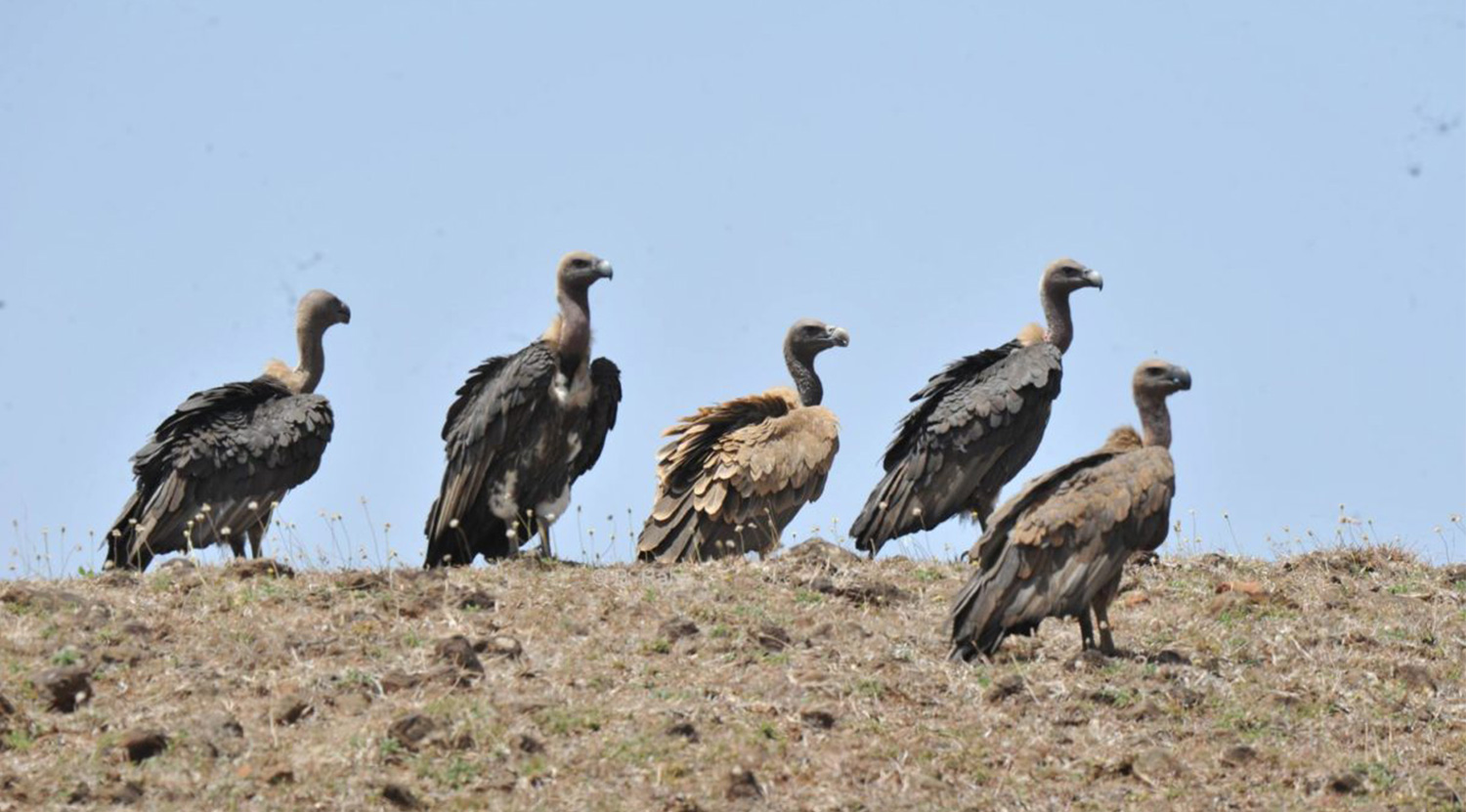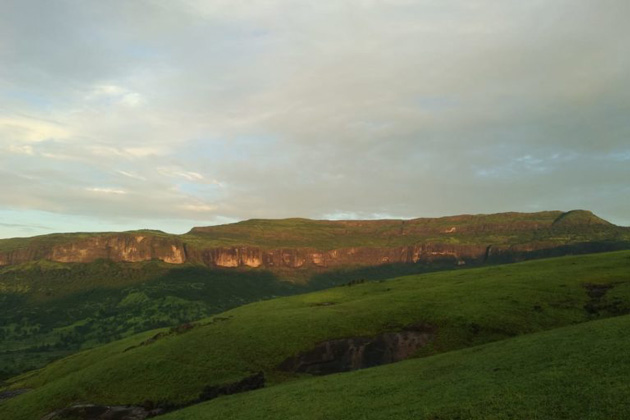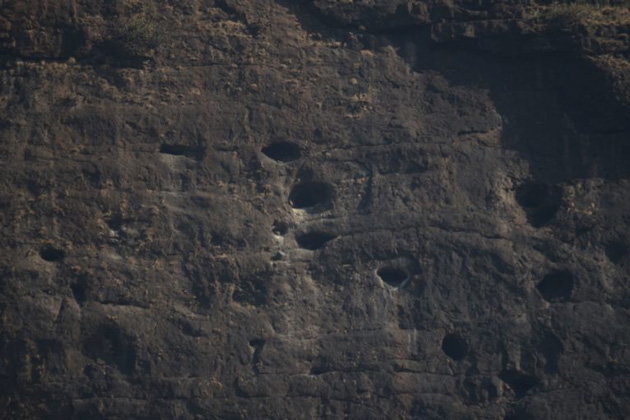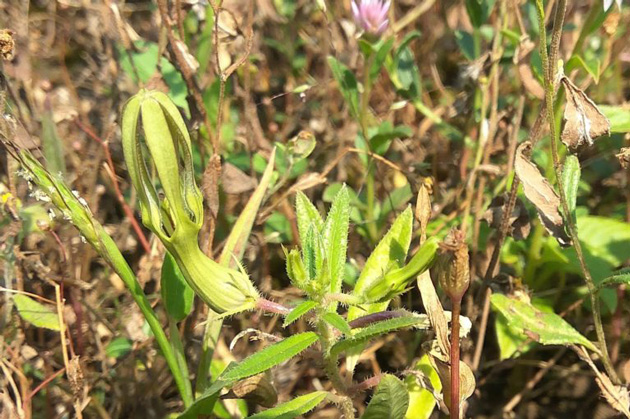Path of destruction: Road to Anjaneri hilltop could threaten fragile rocky outcrop ecosystem

- The Maharashtra government has proposed a 14-kilometre road from Mulegaon to Anjaneri hilltop (near Nashik) through forest land to provide an alternate way to access the temple on the hilltop.
- The hilltop is a site of religious and cultural significance as it is considered the birthplace of Hindu deity Lord Hanuman. The plateau is also important for researchers and conservationists as it is home to several endemic and endangered flora in a rocky outcrop ecosystem and the road project could cause irreversible damage to it.
- The experts note that a road to reach the top of the plateau would have to drill through and cut the sides of the tabletop mountain, which also houses the largest nesting site of long-billed vultures in Maharashtra.
Merely 20-kilometres away from Maharashtra’s Nashik city, the Anjaneri plateau has a good forest patch and is home to at least 105 species of forest and grassland birds including those who have the highest protection under India’s wildlife laws. The plateau also has steep vertical cliffs where long-billed vultures nest in caves but this habitat is now threatened by a road development project.
Following opposition to the project, Maharashtra’s Minister of Tourism and Environment Aaditya Thackeray had recently assured that the road project will not be pursued. But the assurance did not translate into anything concrete and now the project is up for approval under the Forest Conservation Act 1980 seeking diversion of about 17.9 hectares of forest area for it.
Currently, there is a road only up to the foot of the mountain through Anjaneri village. But the concrete road proposed by the Nashik’s public works department would approach the temple from the Mulegaon side of the cliff that goes up to the temple. The estimated cost of the project is about Rs. 200 million.
Pankaj Garg, who is deputy conservator of forests, Nashik West, informed that the project is in progress.
“The Anjaneri plateau has a conservation reserve … the public works department will have to procure a no-objection certificate (NOC) from the state and central wildlife boards,” Garg told Mongabay-India.
He explained that the deputy conservator’s office will inspect the site proposed for the road project after which it will be sent to the central government who will then decide if the project will get clearance for diversion of forests or not.
Five environmental organisations (Nature Conservation Society of Nashik, Eco Echo, GIVE, Apla Paryavaran, Pakshi Mitra Mandal) and 32 social organisations are opposing the road project citing ecological and social concerns.

Kamlu Kadali of the tribal Thakur community, who has been the member of the local administration for several years said there is “already a motorable road till the foot of the mountain, from where you need to walk up stone steps to reach the plateau.”
“Instead of building a new road, repairing the existing road and steps will solve the problems of access here,” said Kadali.
Abhijeet Mahale of Eco Echo Foundation, suggests that instead of the road a palanquin service should be started to help senior citizens reach the top of the hill. “This will avoid the ecological damage that a road/ropeway would cause, and also generate livelihoods for the local people,” he added.
Anjaneri is a religiously and culturally important place
The plateau is also considered the birthplace of Hindu deity Lord Hanuman and every year over half a million people visit the place. The devotees carry water from downhill to offer it to the deity on the top. On Hanuman Jayanti, a yearly festival to celebrate Lord Hanuman’s birthday, devotees even walk barefoot from villages as far as 80–100 kilometres away to visit the temple on the plateau.
“It’s an arduous journey to the top of the plateau that gives these devotees the time to think about the different habitats they see on the way and the natural heritage found here. This connection that binds local communities to nature is sacred and must not be cut off,” Jui Pethe, an independent ecological researcher associated with Nisargabhaan, Nashik-based educational research centre, told Mongabay-India.
The area is important not just for the devotees but also for the Mahadeo Koli and Thakur tribes who comprise approximately 70 percent of Anjaneri’s population. Both communities worship the natural heritage found on the hill.
“We never consume anything we have harvested in our community without first offering it to Anjaneri mata (mother) every agricultural season,” emphasised Kadali.
Yogesh Ganpat Shid, a 23-year-old farmer from Anjaneri village said that the villagers in Anjaneri are concerned that if such a road is built, tourists will go from Mulegaon to the Anjaneri hilltop without passing through their village, which will reduce the cultural importance of their village, and also affect their livelihood opportunities. He pointed out that as of now, there are some small businesses (guides and food shops) which would be adversely affected if tourism through Anjaneri is diverted.
The Anjaneri plateau is a vital place for flora and fauna
Anjaneri is also home to 105 species of forest and grassland birds of which five species are listed under Schedule I of the Indian Wildlife Protection Act, 1972, and five others who are endemic to the Western Ghats. The yellow-footed green pigeon, which is the state bird of Maharashtra, can also be spotted at the place. It also has steep vertical cliffs where long-billed vultures nest in caves.
“There is also a grasslands habitat where leopards and hyenas roam and karvy (a plant found in the Western Ghats) covers the mountain which will be affected if the road is built. A road to the top of the plateau from any direction will have to drill through these habitats,” said Shid.
He said vultures were regularly spotted in Anjaneri village until a decade back but now they are rarely seen. “The numbers of the vultures had declined and are stabilising only now through conservation efforts. A road cutting through their habitat would definitely hurt their population,” Shid told Mongabay-India.

The disturbance in the population of vultures has had some unexpected consequences for the villages around the area as well. “With the dipping numbers of vultures, the number of dogs increased, and with dogs as easy prey, leopards started entering human settlements to prey on the dogs. This led to an increase in human-animal conflict,” Pratiksha Kothule, project coordinator and wildlife biologist at the Nature Conservation Society, Nashik, told Mongabay-India.
Hari Nindekar, van mazdoor (temporary forest guard) with the forest department working on Anjaneri hilltop said that “as of last month, there are 400 vulture nests in the Anjaneri cave habitats.”
Kiran Rahalkar, a wildlife biologist with the Wildlife Conservation Trust, cautioned that “hundreds of thousands of tourists and locals visit the Anjaneri plateau every year” and a “concrete road anywhere near the vulture habitat will result in the extinction of the vulture population in this area.”
While Ganesh Chavhan, another council member of the Anjaneri village, said karvy plant found on the Anjaneri hill would be lost if the road is built. “Karvy is an extremely useful and important plant. My father and grandfather have told me stories about how karvy leaves were fed to cattle during the 1972 drought to help them survive when there was no other fodder around. All this flora will be destroyed in case the project is pursued,” Chavhan told Mongabay-India.
Ecosystem services could take a hit
Known as ‘sadas’ in the local language, rocky outcrops provide essential ecosystem services to communities.
For instance, Hanuman Talaab, a foot-shaped pond on the hill, is a tourist attraction and is used by the local people for bathing. “This pond which is in the shape of a foot is considered to be sacred by the local people, as it is believed that Lord Hanuman once stepped here. A decade or two back, it used to have clean water, which we would use for drinking. If a road is built here, along with the destruction of the biodiversity the local people will lose this source of water,” said Brahmagiri Maharaj, a saint who runs an ashram in the Anjaneri village.
“The Anjaneri dam at the foot of the hill is fed by aquifers on the hill, which will be damaged due to concretisation of the hill for the road and parking on the hill,” Ganesh Chavhan stressed.
Also, the medicinal plants found on the plateau are used by several local people to cure bruises and minor ailments, said Kamlu Kadali.
A critically endangered plant, Ceropegia anjanerica, endemic to Anjnaeri is also found here. The tubers of this plant – called ‘lahaani kharpudi’ or ‘kandil phool’ in the local language – used to be consumed by local people as well as langurs.
“When there is a drought and our harvest is not enough, my forefathers used to get kharpudi and make bread from it for consumption. Now my family does not eat it so often, but we still see monkeys digging up the plant and eating its tubers,” said Kadali, who is now a farmer who grows tomatoes, finger millet and barnyard millet.

Almost 50 percent of the 350 species of plants found on the Anjaneri plateau have some medicinal use, said Jui Pethe, based on a study she conducted in 2012–13.
“People from all around come to Anjaneri to collect these medicinal plants. Today, the number of species found here has increased to 430–450.”
Another study conducted by Pethe in 2015 revealed that there are 57 non-timber forest products on the plateau that provide livelihoods to people from around the Anjaneri area. “This ecosystem needs to be preserved not only for its biodiversity but also to preserve the livelihoods of the people,” said Pethe.
This article first appeared on Mongabay.







